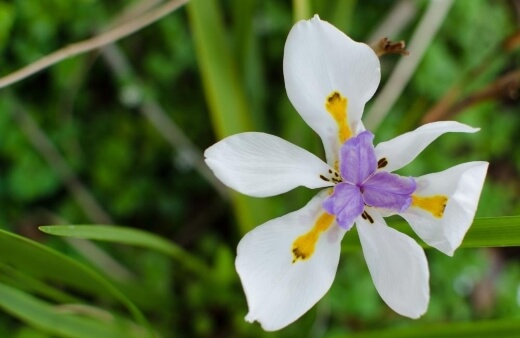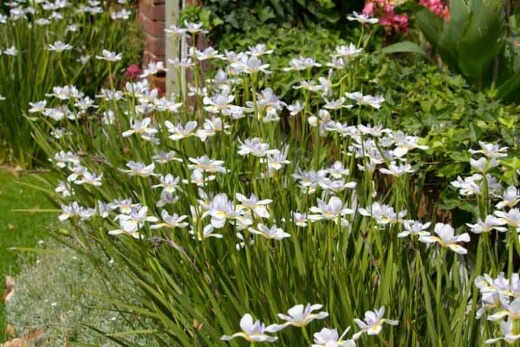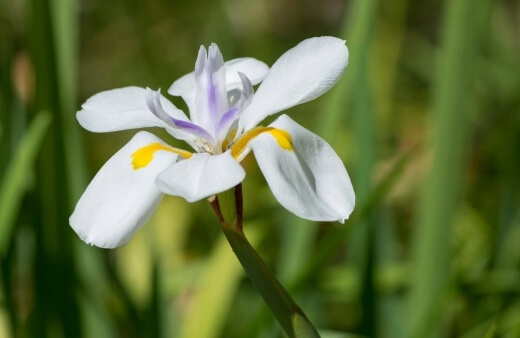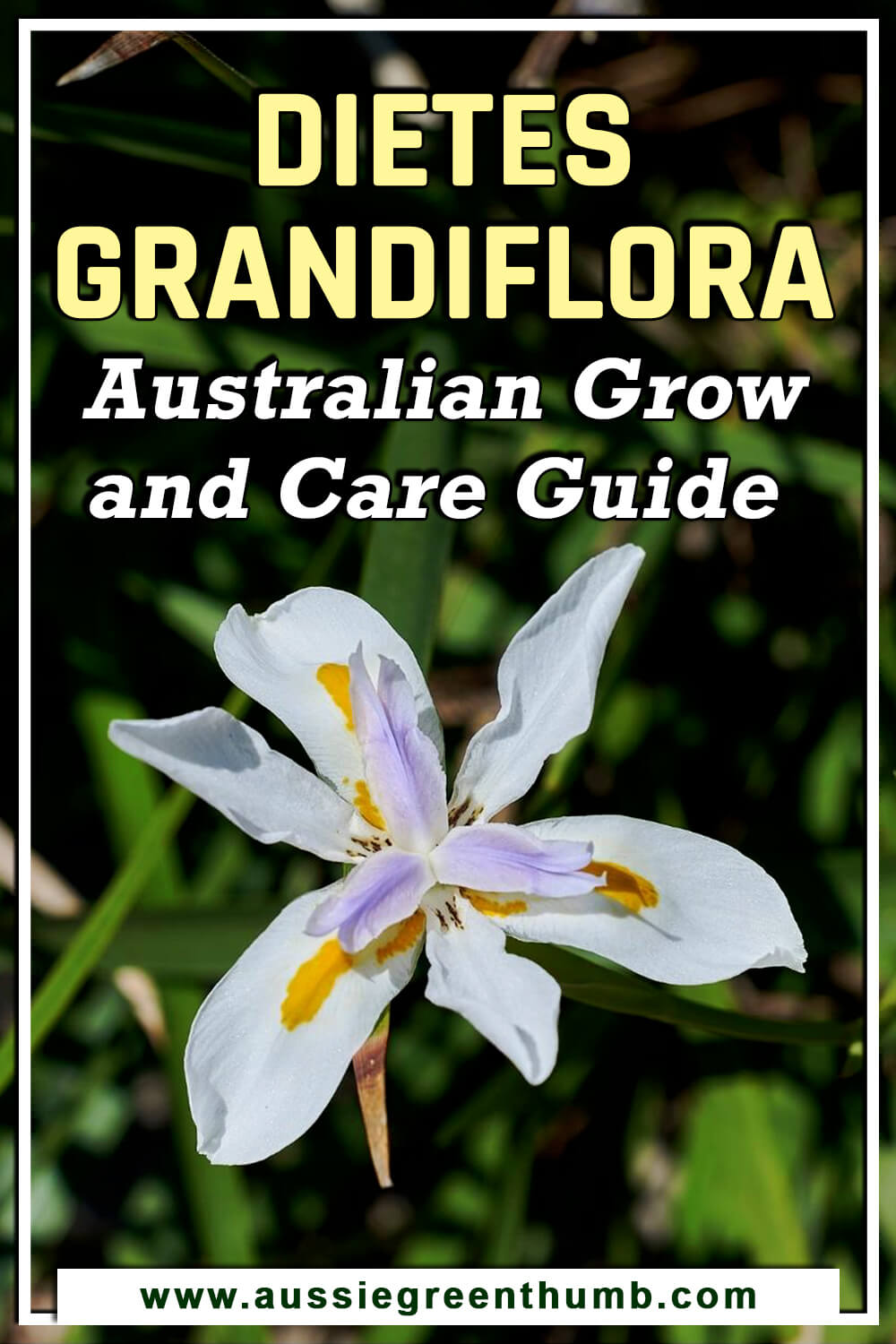Dietes grandiflora, more commonly known as the large wild iris, or fortnight lily, is a herbaceous ornamental grass, prized for its adaptability, sword-like leaves and delicate white and light purple blooms.
Incredibly reliable and hardy, these perennials are often grown as a part of a garden bed, as a feature plant or clumped to create a gorgeous cluster of blooming plants.
Easy to cultivate, easy to grow, here is everything you need to know about growing Dietes grandiflora.
More...
Family: | Iridaceae |
|---|---|
Genus: | Dietes |
Species: | D. grandiflora |
Common Names: | Large wild iris, Fortnight lily |
Location: | Outdoor |
Type: | Flowering plant |
Growth: | 80cm to 1m tall, 80cm to 1m wide |
Sun requirements: | Full sun to part shade |
Foliage Colour: | Green |
Flower Colour: | White, mauve, yellow |
Flowering: | Spring to summer |
Maintenance level: | Low |
Poisonous for pets: | Non-toxic to cats and dogs |
What is Dietes grandiflora?

Thriving across the Southern Hemisphere, the Dietes genus consists of 6 evergreen, perennial plants, part of the Iridaceae family. Of the 6 Dietes species, most are found natively growing in South Africa, with one smaller growing species found on an island off the coast of Australia.
The Dietes grandiflora or large wild iris is one of the better known and most often grown of the Dietes species. This highly ornamental grass often blooms in masses after a long rain and although the flowers are quickly spent, they are a spectacular sight when in full bloom.
The large wild iris is a rhizomatous plant with a distinct clumping habit, which appeals to many growers. It produces stiff and spiky foliage, which grows into a curious sword-like shape.
Amidst the foliage, it produces tall, erect flowers with white and purple-tinged petals. The Dietes grandiflora is a popular landscaping choice, whether for mass planting or an accent plant.
Other common names include:
- Large Wild Iris
- African Iris
- Fortnight Lily
- Fairy Iris
Large Wild Iris Landscaping Uses

Source: alpinenurseries.com.au
These plants are perfectly adapted to a varying range of sun and shade conditions. Coupled with its low level of needs, it can be grown almost anywhere in your garden.
Whether you pick it as a feature plant, add it as an accent plant or use it as a filler plant in between other perennials. Some of our favourite landscaping applications include:
- As part of Mediterranean gardens
- In flower beds for cottages
- In gravel gardens
- Along walkways
- Lining patios
How to Grow Dietes grandiflora
One of the biggest benefits of this blooming plant is its incredible adaptability. It is fairly too easy to grow in most conditions. This plant is happy in boggy, water-logged areas, while still able to thrive in drought conditions.

This is great for Australian gardens, where conditions can vary tremendously depending on where you live. For the best results, you’ll want to grow your large wild iris in a full sun spot in your garden.
Most growers recommend morning sun and afternoon shade or vice versa. Pick a spot with moist, well-draining soil. These plants can adapt to less desirable soil conditions and even clay soils.


Get Your Free Guide:
Master Growing Australian Natives eBook
A Must Have Complete Guide for Every Australian Garden
Get Your Free Guide:
Master Growing Australian Natives eBook
A Must Have Complete Guide for Every Australian Garden
However, if you are concerned about soil quality, some pre-treatment before planting can help to guarantee a happily established plant. Slightly acidic soil is often best. It is important to note that these plants do not make for great indoor plants.
Although they can be grown well in containers or pots, the lack of light indoors makes for a limp, flowerless plant. Rather pick a sun-filled spot on your patio or in your garden. If you’re looking for a Dietes variety which can be grown indoors, consider the Dietes vegeta instead.
Interestingly, however, the large wild iris can be grown as water plants. While it is slightly trickier to establish these plants, they can provide a nice touch in water fountains or ponds.
Growing Fortnight Lily in a Pot
Most growers will opt to grow their large wild iris in the ground, as they tend to establish faster and need less attention. Still, Dietes grandiflora grows quite happily in pots, providing sufficient light, rich soil and space to grow.
If planning on growing in a pot, check out our buying guide on the best potting mixes available online. It is important to note that these plants do not enjoy being root-bound.
As such, it may be necessary to regularly check on soil and roots. If roots are beginning to grow out of drainage holes, it may be time to divide the plant or replant into a bigger pot.
Dietes grandiflora Propagation

Source: gardenia.net
Dietes plants are known to self-sow, so once you’ve planted a few, they are likely to spread themselves freely, provided the space. Nonetheless, this plant can be propagated by means of seeds or by rhizome division.
Fortnight Lily Propagation by Seed
Seeds are not often the first choice for gardeners, as they can take longer to establish themselves and begin flowering. Still, seeds are often readily available from existing plants or local nurseries.
Depending on where you obtain your seeds from, it may be necessary to pre-treat your seeds by soaking them in warm water overnight. Here is what you’ll need to do:
- Store seeds in a cool and dry place until ready for sowing. Spring is often the most ideal time to sow seeds.
- Prepare your area of planting or pot, and sow seeds 1 cm deep, directly into the soil.
- If mass planting, be sure to give your plants sufficient space to grow. Space seeds around 20 to 30 cm apart.
- Keep the soil moist and conditions slightly humid to encourage seeds to germinate.
- Germination can take anywhere between 2 to 8 weeks.
Propagating Large Wild Iris by Division
As these are rhizomatous plants, they make creating new plants incredibly easy. Plants can be divided at any point in the year. However, spring or autumn are often the best time for this.
Here is what you’ll need to do:
- Gently dig up your large wild iris, from the ground or its pot.
- Follow the individual leaf fans to the base, to find where the natural rhizome splits.
- Using a sharp blade, make a cutting through the rhizome. You will want to ensure that each divided plant has enough of the rhizome at the base, and some healthy foliage to help it establish itself.
- Re-plant your divided plants into fresh soil.
- Keep well-watered for the first few days after planting.
Planting Dietes grandiflora
The best time to plant your Grandiflora is during the spring. This provides young plants with all the moisture, sun and warmth they need to establish themselves before the slightly harsher conditions in summer and winter.
If planting in a pot, be sure to prepare a rich, well-draining potting mixture.
Dietes grandiflora Care Guide

The large wild iris is not considered to be a high-maintenance plant, which makes it a dream to care for once it is established. In many cases, especially when mass planting, these plants will require little to no attention from you.
Still, there are certain care aspects one can do to guarantee the health and longevity of their plants.
Watering Large Wild Iris
During the summer, it is recommended to supply your plants with a moderate amount of water every few days. Take care not to overwater. Use the finger method to regularly check your soil or a soil moisture meter for guaranteed results.
Luckily these plants enjoy wet feet and yet, can tolerate very dry soil for a few days. As such, you won’t need to worry too much if you happen to over or underwater from time to time.
What Fertiliser to Use
The large wild iris has limited fertiliser needs. Most often, plants won’t need fertiliser to bloom, unless growing in very poor soils. If you would like to supplement your plants with some added nutrients, consider adding a high phosphorous flower food before the blooming season.
Pruning Dietes grandiflora
Pruning can be done year-round to help control size, remove spent flowers and encourage blooming in the following season. Spent stems, leaves and flowers can be removed once they begin to dry out.
Flowers and seed pods can be deadheaded to prevent spreading and encourage additional bloom.
Pests, Problems & Diseases to Look Out For

Source: randomharvest.co.za
These plants are not known to have any major pest or disease issues, adding to their reputation as a low-maintenance plant. However, if plants become distressed due to sub-optimal growing conditions, they can become susceptible to common garden problems like spider mites.
Be sure to regularly check your foliage for any signs of distress and treat accordingly. Neem oil is often the best choice to combat spider mites.
While some gardeners may recommend a strong stream of water, it is not advisable for this plant as it can damage delicate flowers.
Dietes grandiflora Frequently Asked Questions
Will Dietes grandiflora grow in shade?
These plants are wonderfully adaptable, which means they’ll grow in full sun or part shade. However, large wild iris plants which don’t get sufficient daily sunlight may struggle to bloom as much as counterparts that are grown in full sun.
How long do Dietes flowers last?
The flowers of the Dietes Grandiflora are notorious for being very short-lived. Blooms often only last a day or two.
How big do Dietes grow?
Depending on the growing conditions, these plants are considered to be medium growers, which means they don’t grow too quickly or too tall. On average, the Dietes grandiflora grows to about 15 to 25 cm in height.
How do you prune a Dietes grandiflora?
Pruning is a great way to keep your plants looking healthy and encourage new growth and flowers. When flowers or foliage begin to look faded or dry, it may be time to take to the garden shears and cut back your plants.
Flowers can be deadheaded, and foliage cut back by a few centimetres.
Looking to grow more lilies to your garden? See our how to grow and care guide for Daylilies.

Start Growing Dietes grandiflora Today
Whether as an isolated plant or part of a cluster, you should have very little hassle when it comes to this stunning plant. Considering adding some other perennials to partner with your large wild iris?
Daffodils, tulips, pansies, peonies and violets are all great options. So, there you have it, everything you need to know to have gorgeously growing Dietes grandiflora in your garden.
Published on March 23, 2022 by Maisie Blevins
Last Updated on September 19, 2025





do dietes flowers last in a vase?
Hi there Georgia,
Thanks for the question.
Unfortunately, the flowers of dietes grandiflora do not last for more than a couple of days at best, which means they are alas of little use in a vase.
Should you be interested in growing a flowering water plant for your vase, we have a helpful article on the matter which I will link below for reference.
Best Water Plants for Indoors and Backyard Ponds
Happy gardening!
Gary Clarke
is dietes poisonous to parrots?
Hi Lorraine,
After conducting some extensive research, it seems there is unfortunately little information available regarding the toxicity of the Dietes genus in parrots and other birdlife. However, Iris plants produce bulbs that are notorious for being dangerous to birds and parrots.
Since the Dietes and Iris genera are part of the same family, Iridaceae, and they both produce similar flower bulbs, I would rather be safe and assume that Dietes may not be safe for your parrot.
I hope this information helps.
Gary Clarke